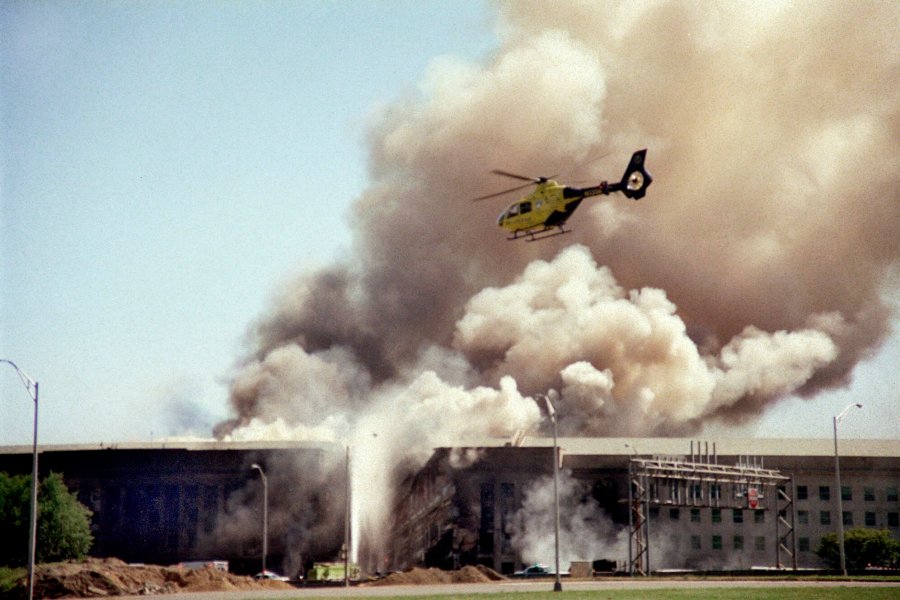VIRGINIA BEACH, Va. (WAVY) – As America eased into its Tuesday routine on the morning of September 11, 2001, the world stopped at 8:46 a.m. That’s when United Airlines Flight 175 flew into the World Trade Center’s North Tower.
Before it was over, Islamic terrorists had hijacked four jetliners and used them as weapons to take down the Twin Towers in New York City, ravage the Pentagon in Washington D.C., and turn an empty Pennsylvania greenspace into a killing field.
Randy Journigan with Virginia Task Force 2, a FEMA team often deployed for urban search and rescue, would later be Rescue Team Manager at the Pentagon. He remembered hearing the news at the Virginia Beach headquarters while meeting with staff. “We saw the second plane hit; and I looked at the crew, my captains and then I said ‘This meeting’s over.'”
Squad member Scott Prentice remembered the uncertainty, “Right now planes are falling out of the sky. We might need to send someone to the roof to look for airplanes because we’re right here in Norfolk and we’re the biggest Naval base on the East Coast.”
Jim Ingledue remembered there was little time to react. A crisis was unfolding. “Our immediate reaction is, ‘hey our friends are in there, the cause doesn’t matter. What matters is trying to get these guys and get them out because we know they’re trapped in there somewhere.'”
All five started north to New York City, but were quickly diverted to the Pentagon.
“Which frustrated all of us knowing that our brother firefighters in New York were trapped and to be honest that’s where we all wanted to be,” said Ingledue. “You know, you’ve never seen anything like that before. So when you see it and experience it for the first time, it’s a learning process you have to do with yourself”
“It was personal that America was under attack,” said Journigan. “Now it’s personal about we got 80 some people. We got to make sure our teammates that come in and come out and they don’t get hurt.”
Rescue squad member Glenn Burnett described going into the damaged Pentagon for the first time. “Walls were blown out. You were climbing over desks, chairs and cubicles. Clean, on this side of the wall. The door was shut. The door did its job. And on this side, hell.”

Patrick Seigh, who was a rescue squad leader, remembered, “We found the nosecone of the aircraft, just the nosecone; it wasn’t the fuselage. And it had punched through the back wall of the ring, and I remember them calling that the ‘punch through.'”
In all, Virginia Task Force 2 spent ten days clearing debris and searching for remains. Scott Prentice recalled taking several days to fully recognize the human toll at the heart of America’s defense.
“And now we had been in the Pentagon for at least six days and you could go ‘there’s someone, there’s someone, there’s someone.’ You just started to be attuned to what you were looking for.”
It was a photograph that made a lifelong impact on Ingledue. Amid the concrete ruins, he came across the driver’s license of Suzanne Marie Calley. “For some reason, I just held onto it for a while. I remember looking at it and looking at her picture and just wondering who she was.”
Calley was a passenger from California on American Airlines Flight 77. She died one day before her 20th wedding anniversary. It is but one story that both haunts and inspires this family of public servants.
What is the lesson of 9/11 to these battle-tested veterans of urban search and rescue?
Glenn Burnett tearfully answered, “It’s pride.” He later lamented what motivated the terrorists. “Trying to understand why someone hated us so much and don’t get it. Somebody hated us. They hated us, and they still hate us. For our freedoms and for what we do cause we’re Americans. We only went through the first inning of this 20 years. We’re not even close to being done, we’re not even close.”
“I could not imagine, until that day, what Pearl Harbor was to my grandparents,” said Journigan. “I know that, a little bit better I think.”
For Seigh, “It was 10 days in our lives. We’re in a significant event in history.”
Journigan summed up his greatest takeaway as a ray of light–optimism that Americans are there for each other when it counts the most.
“Somebody’s coming. And you watch those stories of the community helping their fellow human is the story of 9/11 to me.”
























